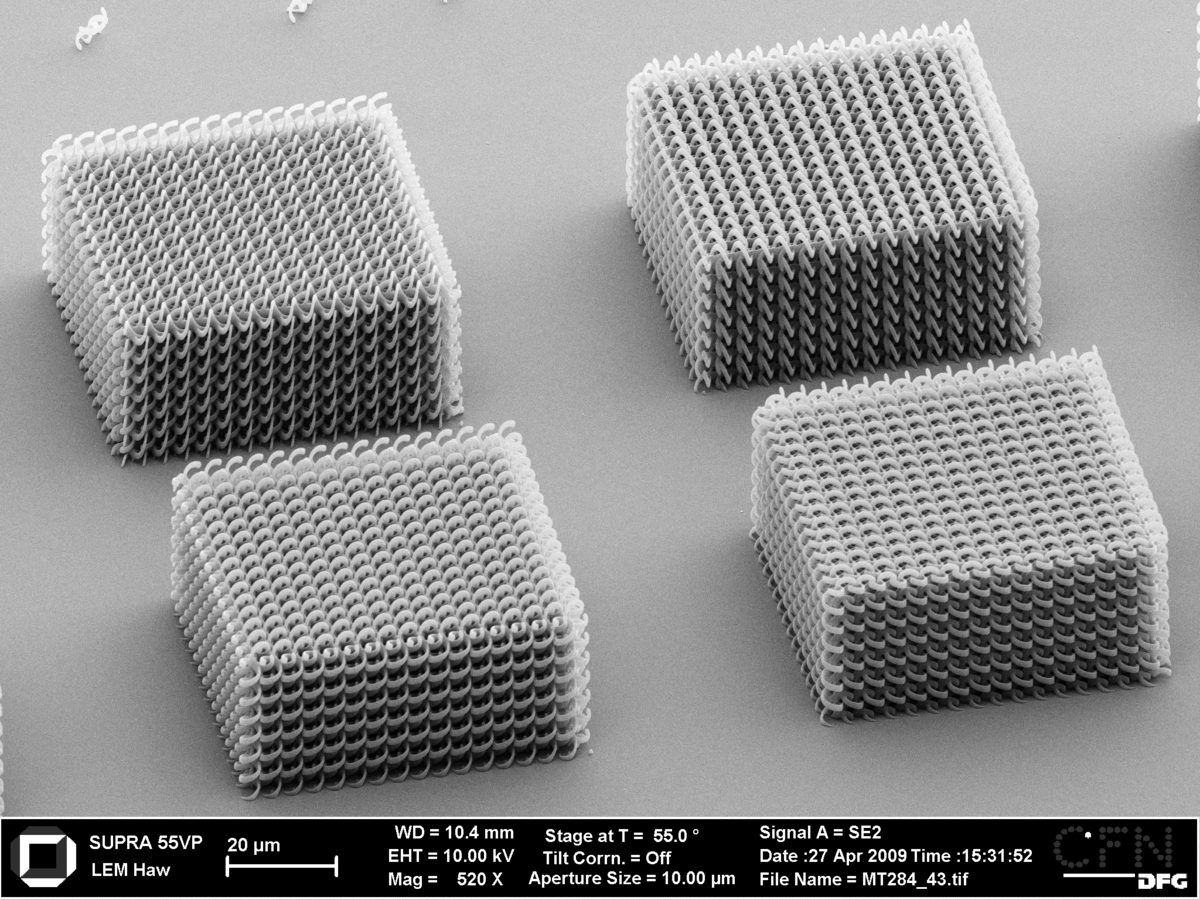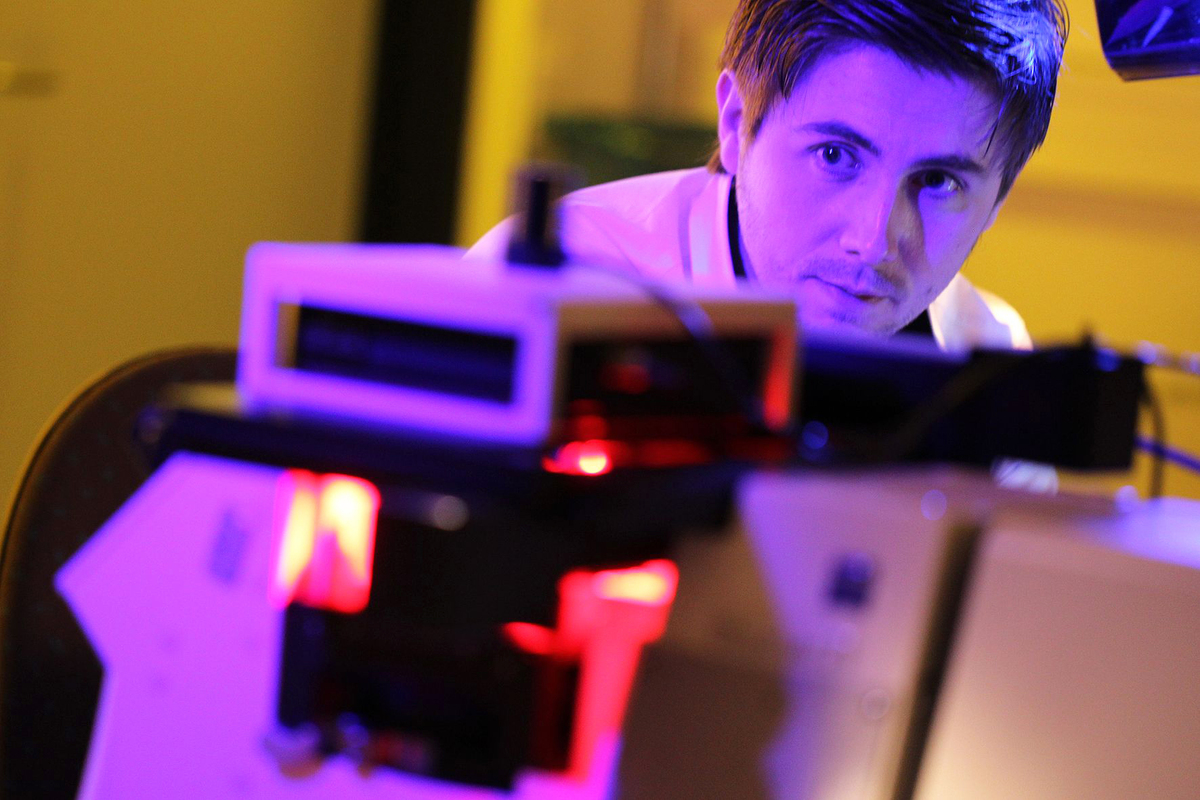Nanostructures Do the Twist
KIT PhD Award for Dr. Michael Thiel in the Competence Area “Matter and Materials”
Dr. Michael Thiel was granted the KIT PhD Award in the competence area “Matter and Materials” for his work at the Institute of Applied Physics and at CFN. Thiel’s PhD thesis covers the “Design, Production, and Characterization of Three-dimensional Chiral Photonic Crystals”.
Since the pioneering publications of Eli Yablonovitch and Sajeev John in 1984, three-dimensional photonic crystals have fascinated the experts. The possibility of manipulating, guiding, or even capturing light in these materials has motivated many scientists to study all facets of photonic crystals.
In optics, it has been known for a long time that light strongly interacts with such crystals if their lattice constant is close to the wavelength of light. Nanotechnology allows specifically producing such architectures, giving rise to optical effects that are much stronger than in natural materials.
The chiral photonic crystals produced and studied by Thiel at KIT consist of “molecules with a sense of rotation”. They are arranged in periodic space lattices similar to natural crystals. Sugar solution is a natural chiral medium preferably used for optical experiments in physics. Polarized Light that enters this solution is rotated a little by each sugar molecule. By rotating an analyzer, the altered orientation of the polarized light can be measured and the molecular sense of rotation can be determined.
Chirality is a major basic principle in nature. The term ‘chirality’ originates from the Greek ‘χείρ’ for hand and may be translated by handedness. The meaning of chirality can also be explained best with the help of hands. Inversion of the left hand yields the right hand and vice versa. Shifting, however, cannot make both hands identical. Simply speaking: A left glove does not fit to the right hand. A molecule is chiral, if it cannot be rendered congruent with its mirror image. Similar to hands, it is distinguished between left and right, such that it is referred to right-handed and left-handed chiral molecules and materials.
Thiel studied the different fundamental interactions between polarized light and chiral photonic crystals using several tailor-made architectures produced by “direct laser writing”. He also analyzed the effects of right-handed and left-handed structures and built “bichiral” photonic crystals. Thiel combined left-handed and right-handed elements in all three spatial directions, thus producing four different types of bichiral crystals: Left-left, right-right, left-right, and right-left. His experiments confirmed that combinations that do not exist in nature have the strongest effects. Based on the results of Thiel’s doctoral thesis, the production method of three-dimensional direct laser writing was improved significantly in collaboration with Carl Zeiss AG and Nanoscribe GmbH.
A first insight into the world of these materials is given by the article “Künstliche chirale Materialien: Wenn das Licht den Dreh raus hat” by Michael Thiel et al. in the journal "Physik in unserer Zeit", Heft 2/2011. All tested possibilities and technical details of improved direct laser writing can be found on the homepage of Nanoscribe.
Career of Dr. Michael Thiel
Dr. Michael Thiel studied physics at KIT and was conferred his PhD with distinction in 2010. During his PhD phase in 2007, he founded Nanoscribe GmbH, a startup of KIT, together with Professor Martin Wegener, Dr. Georg von Freymann, and Martin Hermatschweiler. Today, Thiel is an active partner of this company. He is working in the development division and focuses on the further development of this production process. He collaborates with KIT scientists in current research areas.
In 2007, the physicist, together with his co-founders of Nanoscribe GmbH, was awarded the Otto Haxel Award by the Friends of Forschungszentrum Karlsruhe for “a special scientific achievement that effectively contributes to industrial innovation.” In 2009, he was awarded with the Raith Student Prize at the PECSVIII Conference in Sydney. Now, in 2011, he was granted the KIT PhD Award.
KIT PhD Award
The PhD award granted by the Karlsruhe House of Young Scientists (KHYS) acknowledges the high quality of young scientists at Karlsruhe Institute of Technology (KIT) who contribute significantly to the success of KIT. The PhD Award is granted for excellent PhDs in the six KIT competence areas: Matter and Materials; Applied Life Sciences; Earth and Environment; Technology, Culture, and Society; Information, Communication, and Organization; Systems and Processes. The Award is handed over at KIT’s annual celebration and endowed with a total of EUR 12,000.

